Articles
"Beauty Unadorned":
Dressing Children in Late Nineteenth-Century Ontario
Comme toutes les manifestations de la culture, la façon d'habiller les enfants reflète les attitudes sociales d'une époque. L'attention accordée a l habillement des enfants à la fin du XIXe siècle s'inscrivait dans un souci plus général de leur développement mental et de leur éducation morale. Le present document traite des attitudes dominantes à l'égard des enfants en Ontario au XIXe siècle, ainsi que de leurs répercussions sur le vêtement de l'enfant. On y étudie en particulier les questions relatives à l'hygiène des enfants, qui avait une incidence sur leur habillement, et les tentatives de définition du sexe et de l'âge d'un enfant par le vêtement.
Résumé
Like all manifestations of culture, the way in which children are clothed reflects the social attitudes of the time. The concern for proper practices of dressing children in the late nineteenth century was part of a larger concern for their mental and moral development. This paper discusses the prevalent attitudes to children in nineteenth-century Ontario, and the influence those attitudes had on children's dress. In particular, the issues in children's health care affecting the way children were clothed and the attempts at sex and age definition through children's dress are examined.
Children in Nineteenth-Century Ontario
1 In the early years of settlement in Ontario and continuing later in rural areas, attitudes to children were shaped, to a large degree, by economic exigency. The frontier family formed an economic unit, with all members participating in the work of clearing land, farming, or running small workshops or businesses. Children were valued as potential contributors to that unit. The childhood years were not valued as a separate time of life; rather, young children were encouraged to move quickly out of infancy into young adulthood. At an early age, children participated in the labour-intensive activity of the family, and their contribution grew in proportion to their age and physical growth. In this close economic unit, both parents shared in the child's upbringing.1
2 By the 1850s Ontario was undergoing a transformation. While much of the province was still devoted to agriculture, the trend toward rapid industrial development, new transportation systems and tremendous urban growth had begun and was to accelerate in the decades following.
3 Compared with rural areas, the city produced new and visible problems that the moral-conscious middle class strove to alleviate or reform. One of the major urban concerns was children without support: the orphaned, poor, sickly, and abandoned. This focus on children was an example of the major shift in attitudes to children in nineteenth-century Ontario. Before 1850 these children were treated as part of the general pauper population and were institutionalized along with destitute adults in poor houses or hospitals. In the second half of the century, specialized institutions were created to deal with children, such as the Protestant Orphans' Homes. The creation of institutions exclusively devoted to the welfare of children was evidence of the growing recognition of childhood as a special time of life, requiring protection and segregation.2
4 Ontario school reform was another result of the changing perception of childhood. In Ontario's early years schooling was provided on an informal basis at home, at a private teacher's residence or the occasional common school. A child's parents or guardian chose whether a child would attend school and for how long, which often depended upon the work demands at home.
5 After 1840, the school took on more and more of a role in providing a protective environment in which children could develop morally and intellectually. School legislation made this possible by the formation of free public schools, the expansion and centralization of a school system, and, by the School Act of 1871, compulsory education for all Ontario children.3 Schooling prevented children from being quickly assimilated into adult activities. School children became a breed apart, requiring their own special equipment, literature, activities and clothes.
6 The middle class promoted public institutions, such as Orphans' Homes and public schools to protect and provide direction for children. They also believed that the foundation of society was the family. The "responsible" family in mid- to late nineteenth-century Ontario was understood to be from the ranks of the urban Protestant middle class.4 The urban middle-class family did not form an economic unit, as did the rural family. Father left home every day for the office, factory or shop. The middle-class home was seen as a sanctuary, separated from the vices and clamour of the city, providing peace and support for father, and protection and guidance for the children. Unlike the mother of a rural family, who participated in the economically productive activity of the farm, the urban middle-class woman was expected to devote her time to home maintenance, social duties, and management of children.
7 A proliferation of child-care guides provided detailed instruction on the proper care, feeding, clothing and disciplining of children. Mothers were instructed to ensure the child formed good habits in work, play and social activities. The emphasis was on social control; children, by virtue of their dependence and vulnerability, needed special attention and guidance.
8 Many child-care guides focussed their attention on the physical well-being of the child, a result of an increasing interest in the "science" of the body and medicine. The guides advocated greater involvement of the mother in the health of her children, for example, by breast-feeding. They advised that mothers take the time to provide all the elements of good health for their children: exercise, outdoor activity, loose clothing to allow freedom of movement, fresh air, and simple, nourishing food. Management of children, they believed, was generally either too lax or too confining; children should be encouraged to participate in those pastimes recognized as part of "childhood."
9 As the nineteenth century progressed, the middle-class family showed greater concern and exerted greater control over the health, behaviour and appearance of their children. There was an awareness of the specialness of children, and a corresponding awareness of the need for protection and control. Unlike the rural child, valued for his contribution to domestic labour, the middle-class child was valued as a representative of the family's station in society, reflecting the parents' tastes, learning, wealth and gentility (fig. 1).5
10 While some of the new interest in children respected the child's individuality and need for freedom, it also spurred an increasing emphasis on the child as an extension of parental ambitions and status in society. Children's dress came to play a large part in this new interest.
Issues in Dressing Children
11 Child-care guides, household manuals, health-care books, and women's periodicals all had much to say about children's dress. Literature on child care was popular from the early nineteenth century, published in Britain and North America, and written by experienced mothers, and religious spokesmen and women through to the end of the nineteenth century. By the 1870s, however, new types of authors contributed to the literature: social reformers and educators who viewed child care as a means to a better society, and physicians, who explained child care in scientific terms. By this time, child-care guides were being published in Canada.6
 Display large image of Figure 1
Display large image of Figure 112 The child-care literature was aimed at the middle-class wife and mother who often had the sole responsibility for the well-being of her children. The literature subjected traditional practices in dressing children to the scrutiny of science, while informing the mother about physiology and hygiene.
13 The child-care advice was usually vociferous in urging mothers to dress their children to allow for the growing body and freedom of movement. The customs and fashions of the period showed the effects of this advice in the development of practical and suitable clothing styles. But the strength of the reformers' pleas is an indication that they were trying to curb the current trend for dressing children in clothing that was restrictive, fussy and impractical.
14 In the dressing of children, the child-care guides cautioned against several general practices that caused restriction to movement and bodily processes. For infants, advice included loosening the restrictive binder or "flannel band," as it was advertised in the Eaton's catalogues. The band, a bias strip of cloth, was wound around the baby's abdomen, to support the back and the dressing of the umbilical cord, and to supply warmth. The guides also cautioned that infants' dresses should not be so long or cumbersome as to prevent the free movement of the legs and feet.7
15 The major issue in the literature was the tightness of girls' underclothes. This was one issue of many in the dress-reform movement of the 1870s, and 1880s, which aimed at changing the damaging effects fashion had on the health of women and girls. Boys' clothes were considered sensible and healthy, but the corsetting of young girls caused lengthy debate and often vehement protest. It was generally admitted that some corsetting was essential to the health and comfort of young daughters, whose growing bones and muscles needed support.8
16 The real problem was the tight lacing of the corset, which changed the natural, growing proportions of girls into the desired fashionable silhouettes. Tight lacing was said to be the cause of a long list of health problems including weakness of the lungs, poor circulation, displacement of internal organs, palpitations of the heart and even consumption.9
17 Fashion often turned a deaf ear on this "slaughtering of the innocents."10 Corsets for children were common in commercial advertisements, and fashion plates showed children's dresses cut to fit a fashionable figure, made possible only by tight lacing. But some corset companies offered products that gave support, but not constriction, made of lightweight, more elastic materials, stiffened with fine flexible whalebone of cotton cording in place of heavy whalebone or metal. The Eaton's catalogues of the 1880s and 1890s advertised the American-made "Ferris Good Sense Waists" (fig. 2). These corsets were clearly shaped to fit the natural lines of the body, with no constriction at the waist or bosom. They also had a ring buckle at the hip to which was attached a strip of elastic to support stockings. This was an improvement over garters, which fastened around the leg, tending to "prevent the free circulation of the blood, to say nothing of the discomfort of the poor child."11 Some corsets had buttons to which petticoats and drawers were attached, so that these heavy items were supported by the shoulders, rather than the waist. Like the corset, petticoats were not condemned — just the manner of wearing them.
18 Another constriction to both boys' and girls' bodies that child-care guides protested was the wearing of tight, fashion-conforming footwear, considered very injurious to growing feet. Boots were particularly bad, and the guides recommended that "shoes are far preferable to boots: boots weaken instead of strengthen the ankle."12 In Ontario children's portraits, the "dress up" footwear was the tight side-buttoned boot (fig. 7), while rugged laced boots were worn for school.
19 Another crime of fashion was the vogue for dressing children in low-necked frocks whatever the weather. This practice was a hold-over from the early nineteenth-century belief in "hardening" or the strengthening of the child's constitution by exposure.13 The fashion was popular through to the 1870s, and family portraits of this period show all the women with standing collars, and the children in decolletage.
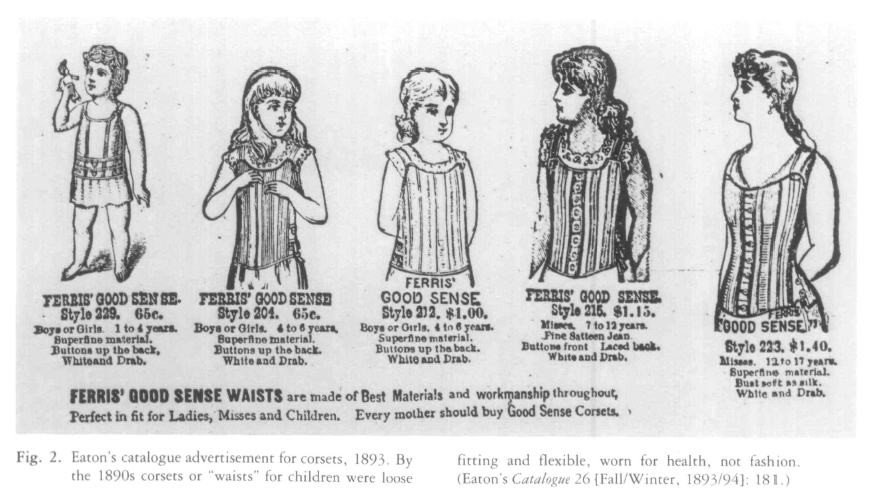 Display large image of Figure 2
Display large image of Figure 220 By the 1880s bare shoulders had disappeared, replaced by the opposite health craze: wool next to the skin. Child-care guides advocated that every inch of the child be covered with woollen undergarments, since it was believed that wool flannel, being a poor conductor of heat, protected the body from changes in the weather (fig. 3).14
21 The concern for suitable underclothing for children extended to outer clothes, as well. Children's fashions generally paralleled adult fashion, but any style that was adapted to suit the needs and activity of growing children was applauded.
22 An example is the pinafore, an article of clothing specially designed for children to protect their clothing from soiling from school, play, work, or outdoor activity. Pinafores were first worn early in the nineteenth century and were plain covers with a drawstring at the neck. By the end of the century there were many styles, usually in white cotton or linen so they could be bleached clean.15
23 The child-care guides prescribed plenty of outdoor exercise for children. Fashion corresponded with garments especially designed for active outdoor and sports wear. For example, the bathing costume, properly worn by children by the 1870s, consisted of a loose tunic and knickerbockers. By the 1880s, a one-piece bathing suit was introduced, made of stretchy jersey cloth. Jersey became very popular for all children's garments, being very comfortable, practical and warm, but not heavy (fig. 4)
24 A new garment was worn for exercise at school. School planners believed that sitting for long hours in the classroom was unhealthy, particularly for urban children. Exercise classes were introduced into the Ontario school curriculum by the 1860s.16 Children were trained in calisthenics, gymnastics, and bar-bell or Indian club exercises. Boys wore their sensible school clothes to class, but a special dress was designed for girls, consisting of a loose yoked blouse and skirt, and knickerbocker drawers.17
25 But the movement toward greater freedom in children's dress did not proceed uninterrupted. In the late nineteenth century, there were very divergent trends. On the one hand, the greater awareness and appreciation of children led to the adoption of many modes of dressing and styles of garments of greater simplicity, comfort and practicality. On the other hand, the awareness and appreciation led to the extreme "dressing up" of children to please their mothers, their family, and their society, rather than for the children, themselves. This "conspicuous consumption" was made possible by a rising standard of living for the middle class, and a corresponding rise in mass production, marketing and advertising.18
26 Contrary to the advice about the length of infants' dresses, the fashionable length as shown in portraits of the 1890s was longer than it hail been for one hundred years. The well-dressed baby was an emblem of material pride and achievement — "nothing can be considered too elaborate for our young people," claimed the T. Eaton Company catalogue of 1888.19
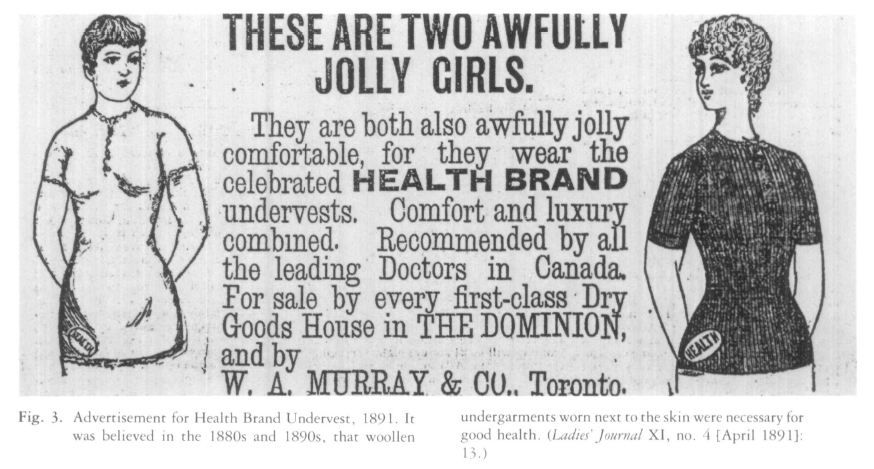 Display large image of Figure 3
Display large image of Figure 3 Display large image of Figure 4
Display large image of Figure 427 Children were often dressed in clothes made of fashions that were completely impractical for any active child, such as velvet, plush, and silk, trimmed with embroidery, and fur, tied around with huge sashes and bows (fig. 1). On the feet were worn tight-fitting high-buttoned boots.
28 Child-care advisors protested this excess of fashion for children because it restricted not only the physical, but also the mental and moral development of the child. Mothers fostered pride and vanity in the impressionable minds of their children to the horror of the experts:
29 Fashion often presented a romantic, rather than realistic, view of children. Little boys were dressed up like-storybook characters, inspired for example, by the illustrations in the child's story Little Lord Fauntleroy, whose little hero sported a version of cavalier costume of the seventeenth century. This "antique" fashion persisted into the twentieth century and was hateful to little boys. Girls, too, were dressed in fussy garments inspired by storybooks, such as those illustrated and/or written by Kate Greenaway. The Greenaway style was a vague Regency revival, and the nostalgic old-fashioned style made girls look feminine, quaint and coy. Unlike earlier children's books of edification and religious tract many of the storybooks of this period were written for the delight of children. It is perhaps ironic that these books inspired fashion to design garments for children that were a misery rather than a delight to wear.
30 Middle-class romantic interest in things military, folksy and exotic translated into miniature copies of uniforms and costumes for children. Portraits abound of little soldiers, little peasants, little sailors and even little Turkish odalisques.
31 So, while mothers were counselled in providing loose, comfortable clothing for their children, they were also lured by fashion fads reflecting a sentimentalized view of children.
Gender, Age, and Dress
32 Fashion played a large part in indicating the sex and age of children in the late nineteenth century. There have always been particular garments and clothing styles marking the passage from one stage of childhood to the next. Until the end of the eighteenth century, there were only three clothing stages: the swaddling clothes of the baby, the petticoats of infancy and the miniature copies of adult clothes for the child. Boys and girls dressed alike, until they assumed adult clothes, when their garments began to represent their sex and role in life. Girls continued to wear female fashions, while boys were breeched, that is, they gave up petticoats tor the adult breeches, waistcoat, shirt and coat.
33 As the nineteenth century progressed, more stages in the early years of life were recognized, marked by particular garments and styles. The new styles were necessary to accommodate a new concept of childhood as a special and complex time of life with several recognizable stages, each stage worthy of its own clothing styles. The consecutive stages are discussed in detail below.
34 The garments the baby wore were called long clothes because they reached below the feet. They included the flannel binder, for warmth and support, the shirt or waist, long petticoats, long robe and cloak.21 Child-care literature recommended dressing baby in short clothes as soon as possible, from three to eight months.22 Short clothes allowed the crawling infant and early toddler freedom of movement. Short clothes included petticoats, dresses, drawers, pinafores, cloaks, hose and buttoned boots or laced shoes.23 Short clothes took on some of the features of current adult female fashion. For example, the large puff sleeve of the early 1890s was copied in the toddlers' dresses (see figs. 1 and 5).
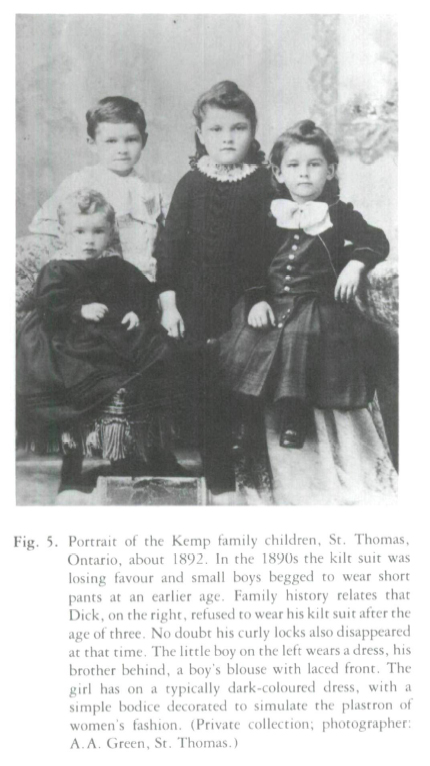 Display large image of Figure 5
Display large image of Figure 5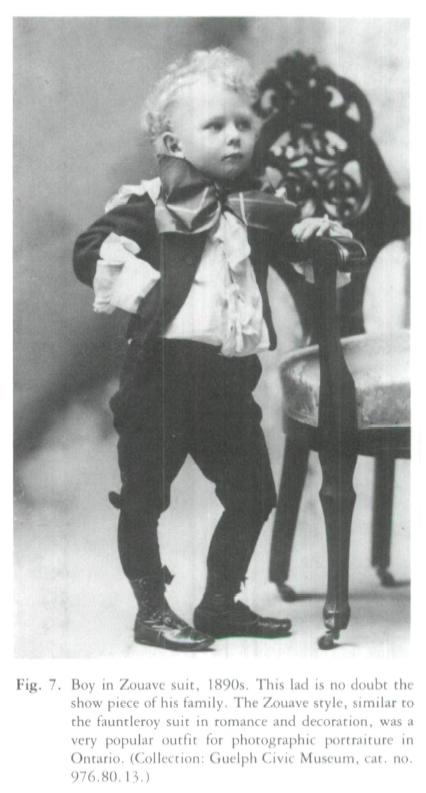 Display large image of Figure 6
Display large image of Figure 635 There was little or no differentiation between boys and girls at these two "petticoat" stages. Indeed, in photographs of children under three years old, it is difficult to tell whether a child is a boy or a girl. Both wore garments indicating their subordination to their parents: the dresses trimmed with lace, velvet and ribbon.
36 This holding back from sex identification also reflects the current idealized view of childhood as an age of sexless innocence. Late nineteenth-century attitudes no longer invested children with original sin, and they were not yet influenced by the psychological theories of Sigmund Freud. Sentiment of the time took delight in infant androgyny. Even deliberate mixing up of sex identification was popular, such as the vogue for long curls for boys and cropped short hair cuts for girls (fig. 4).24
37 Boys at the age of three to six were ready to wear transitional garments defining them as male, but not yet ready to don men's clothing. The kilt suit was one of the most popular garments to bridge the gap between frocks and the eventual trousers (fig. 5). This fashion, starting at the height of the romantic Highland revival in the 1830s, provided an easy transition: being still like a skirt, but identified with the clothing of the Scotsman. Harper's Bazaar of 1893 explains the transition from petticoats to kilts:
Usually made of checked woollens, the kilt suit comprised a kilted skirt, attached to an underbodice, with buttoned waistcoat and open jacket.
38 A variety of forms of the knickerbocker suit was worn by little boys concurrent with the kilt suit. Knickerbocker suits, so-named after the fanciful seventeenth-century Dutch settlers in an 1859 Washington Irving burlesque, were characterized by short pants and fancy top or tunic (fig. 6).
39 Another little boy's fashion was the Zouave suit. When first introduced in the 1860s, it was more tailored and truer to the original. In imitation of the Zouave or French Light Infantry uniform, it was characterized by a short, rounded and collarless jacket and full breeches closed at the knee. By the 1890s, it had become a very fancy outfit, worn with a lace- or ruffle-trimmed puffy shirt and a huge silk bow at the neck (fig. 7). The Eaton's catalogue called this style a fauntleroy or brownie suit. The latter term probably derives from the extremely popular series of children's books, starting in 1887, called The Brownies, Their Book. Whatever term was used to describe it, the small boy's romantic decorated and fussy suit was the choice of many a proud Ontario mother for her "darling's" portrait.
40 By far the garment most universally worn and lasting in popularity was the sailor suit, designed fur small boys and even older boys (fig, 8). Worn first by the five-year-old Prince of Wales in 1846, it had every advantage: it had the romance of military costume, inspiring pride in the parents of the "little sailor"; it delighted rather than, like the fauntleroy suit, plagued its wearers: it was very comfortable; it could be worn for casual occasions, or, dressed up with gold braid, was suitable for parties; it was simple to produce for the growing ready-made market. The T. Eaton Company store had a large trade in sailor or, "blouse," suits and claimed: "Nothing is more stylish for a child than a neat, not too elaborate blouse suit...We are showing, we believe, the largest display of these garments on the side of the continent."26
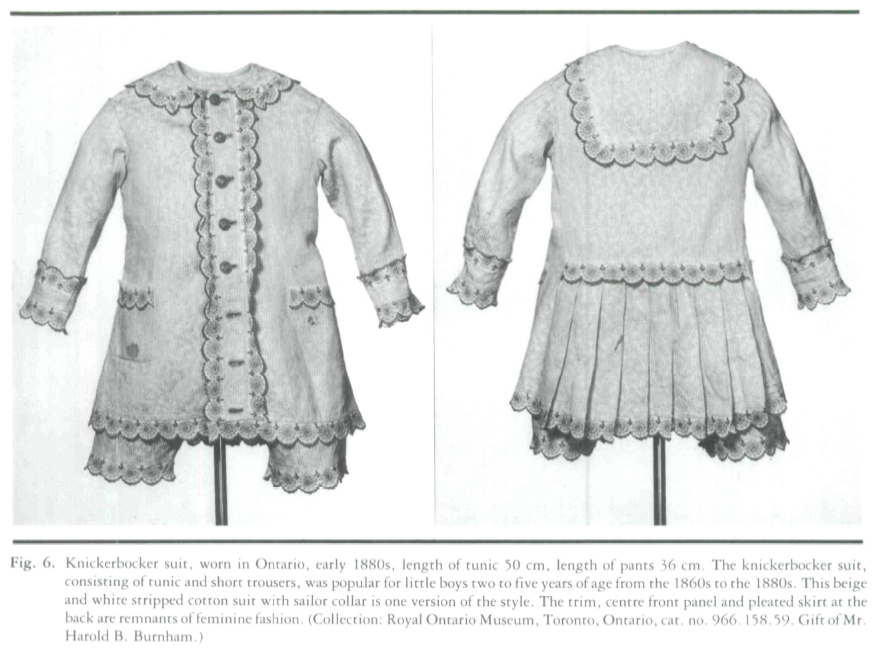 Display large image of Figure 7
Display large image of Figure 741 At five or six years of age, boys began to wear garments that were tailored like men's clothes (fig. 1). This coincided with beginning school: "At six years of age, boys put on short trousers and wear the plaited Norfolk jacket, a patrol jacket or a double breasted reefer coat as the coat of their school suits."27 With these school suits, boys often wore a blouse, or waist, with a sailor or frilled collar and cuffs and a large bow tied at the neck — last remnants of the "girlish" fashions of their earlier years.
42 At this age, boys were expected to begin taking part in activities associated with their masculine role. As in the adage "boys will be boys," they were encouraged to be rambunctious and even mischievous. The practical clothing for this age must have helped to make this behaviour tolerable. Near the age of thirteen, when a boy was ready to enter an adult world of work or higher education, short pants were changed for long trousers to be worn with regular shirts and suspenders.
43 The age of "breeching," or transfer from skirts to pants became progressively younger through the 1880s and 1890s. At the same time, transition garments such as the kilt and the knickerbocker suit lost popularity, and boys were put into adult tailored clothes much sooner (fig. 5). This could be because boys at school in the changing urban, industrial society needed to show aggressiveness, independence and competitiveness to get ahead.28 Masculine clothes suited the new schoolboys in a changing society:
44 Girls' garments, after the long and short clothes stages, took a completely different path from boys. Centuries ago, a three-year-old girl was dressed in a style that would remain unchanged for the rest of her life. After her brothers exchanged dresses for breeches, she continued to wear the same miniature adult gowns. This could be because a female's status remained essentially unchanged from girlhood through her adult life; she was subordinate and dependent first as a daughter, then as a wife.
45 Clothing for girls in the nineteenth century did not follow this pattern completely. Girls did not have the distinctive transitional clothes, such as knickerbocker or kilt suits that boys did, but there were differences between girls' dresses and those of their mothers. The differences became more and more pronounced as the century progressed. "The time has gone by," claimed the Ladies Journal of 1884, "when the elaborate designs for grown women were reduced in size merely for their young daughters."31
46 The most noticeable difference between women's and girls' dress was the length of the skirt. The younger the girl the shorter the skirt, although the exact length of skirt by age changed with fashion. As skirts lengthened, girls' hair went up. Up to about the age of fourteen, although there was much variation, girls wore their hair over their shoulders in the popular manner, whether in braids, or loose. When ready to enter the adult world, girls pinned up their hair, like their mothers.
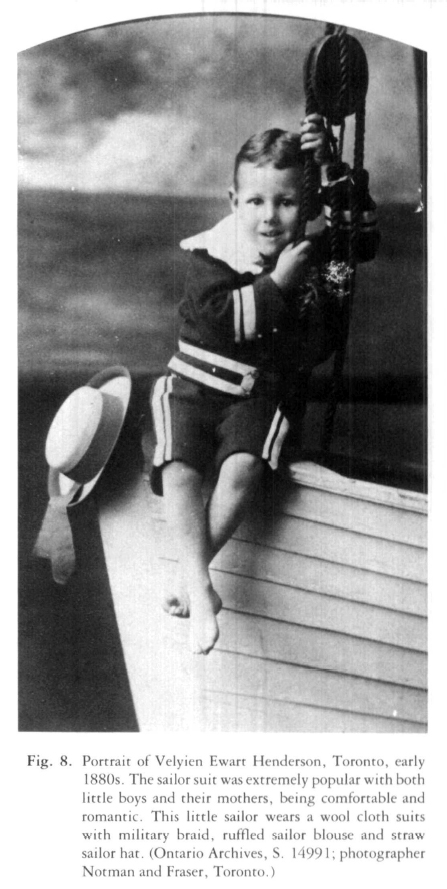 Display large image of Figure 8
Display large image of Figure 847 Girls' garments took on the general style of the period. Portraits of children show, for example, all the changes in the shape of the sleeve and decorative trimming during the 1880s and 1890s (figs. 1 and 5). But girls' clothes were worn much looser than the adult garments, and in some cases were constructed in a particular way to fit a young figure. While the 1880s woman's bodice was fitted over an hourglass corsetted figure, a girl's bodice was draped loosely over a sash or belt (fig. 9).
 Display large image of Figure 9
Display large image of Figure 9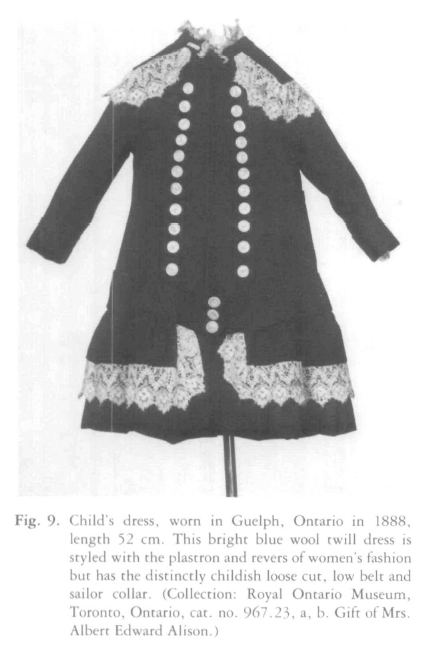 Display large image of Figure 10
Display large image of Figure 1048 In the 1890s, a garment was designed that even more diverged from adult wear: a loose frock falling free from a yoke or smocked bodice (fig. 10). These changes in outer garments corresponded with changes in underclothing. Corsetting forced the child into the bearing and behaviour of the adult, but by the 1880s girls were allowed to be girls for a longer period of time. The practice of tight-lacing girls' corsets was on the way out, and girls began wearing corsets at a progressively older age.
49 Attitudes to girls in general were changing, which was reflected in their clothing. Girls were no longer expected to be fragile and timid creatures. Rather, they were encouraged to be active and robust: "She of the sparkling eye, the strong, round arm, and the deep chest, who can swim and row and ride horseback, and tramp five miles — this is the girl the times demand."32 Girls' status like their mothers was changing, as they began to engage in new roles in sports, higher education and care.33
50 The new, active image of the girl of the 1880s required loose, practical clothing styles. The sailor suit, which was popular for boys since the 1860s, was adapted for girls, as a sailor blouse, worn loosely tucked into a pleated skirt. Simple outfits made of jersey were also worn by boys and girls alike, with short trousers and skirts, respectively. For school and for casual, girls wore practical loose yoked frocks and pinafore dresses.
51 By the late nineteenth century, the early years of life had come to be seen as fundamentally important, and the upbringing of children, especially the manner of dressing them, was a grave concern. Young people no longer went from the petticoats of infancy straight into adult garments. Rather, they were protected from adult society for a longer period and wore garments indicating a transitional period.
52 New interest in children's development resulted in both a respect for the child's individuality and "childish" pursuits, and an emphasis on the child as an extension of family ambitions. Child-care guides advocated that "childhood, like beauty unadorned,' is adorned the most,"34 but the garments chosen by Ontario parents for their children to wear in their photographic portraits vary from simple and comfortable to elaborate and ostentatious.
The child-care guides consulted in this paper present the prescribed view of child rearing. Often written in the language of social reform, they were trying to change traditional and entrenched practices of dressing children and represented a new ideological standpoint on children and health. An examination of other sources by individuals, such as memoirs, journals and letters, might show if, when and how the new ideas penetrated family life.
The fashion periodicals consulted also present a prescribed view of how children should be dressed, whereas the mail-order catalogues, photographs and original garments show what was actually worn. These latter, although rich in relevant information, are limited in some ways. There is little record of what kind of people ordered children's clothing from, for example, the Eaton's catalogue, and in what quantity, and for what occasions. While all of the photographs surveyed are part of larger Ontario collections, few have specific information as to the identity of the subject or the date. The unidentified photographs are dated by clues such as the format of the photograph, the adults' clothing and furnishings in the picture. Therefore it is possible to make a general judgement about the fashionableness of Ontario children's clothing, but not about when specific styles were introduced. Sometimes the fabrics, fit, and trim of the garments can be identified in the photographs, but it is usually impossible to tell whether the clothes were tailor, home- or ready-made.
The photographs are more revealing about what children wore for special occasions than what they wore for every day. Most of the portraits were taken in a photographer's studio, and the children were carefully dressed in their best and newest clothes. However, some of the photographs surveyed were taken by amateur photographers and provide more candid pictures of children playing and working indoors and out in their casual clothes.
Children's garments usually have survived one hundred years because they were worn for special memorable occasions or were particularly fine. Like studio portraits, they do not often show what was ordinary wear.
In general, all the sources — child-care guides, fashion magazines, catalogues, studio and amateur photographs, and original garments — represent children's dress from middle-class families. It would be necessary to consult different sources for lower-class children's dress.